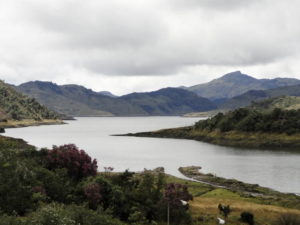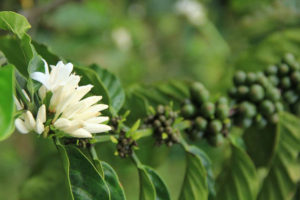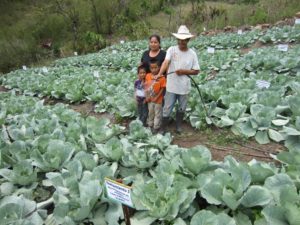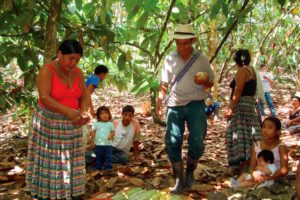
In light of its standing as a regional research platform and a higher education institution of international recognition, CATIE (Tropical Agricultural Research and Higher Education Center) holds an undeniably important position in Latin America and the Caribbean.
The work carried out by CATIE researchers is focused on generating and disseminating knowledge, putting it into practice and encouraging uptake. From restoration to climate change adaptation and mitigation, conservation strategies and silvopastoral systems, the center’s work spans not only numerous countries but also several decades.
To mark CATIE’s official 45th anniversary this year, Environmental Livestock Unit researchers Cristóbal Villanueva and Danilo Pezo, Forest Seed Bank head Francisco Mesén and genetic resources expert William Solano spoke about key work and achievements.
Read also: CATIE celebrates 45 years of putting knowledge into practice
What is the history behind the development and use of research on silvopastoral systems at CATIE?
Cristóbal Villanueva and Danilo Pezo: CATIE’s work on silvopastoral systems started in the late 1980s, but initially the emphasis was on the use of tree fodder as a source of feed for ruminants.
Initially, most of the efforts were on native trees such as Erythrina species, Gliricidia sepium, Leucaena leucocephala and Calliandra calothyrsus, as well as the introduced Morus alba. All these were managed under different silvopastoral options, mostly the traditional live fences, and intensive fodder banks and alley farming with pastures systems.
Later, emphasis was put on other woody perennial species as well as on the role of different silvopastoral options — such as the most commonly practiced scattered trees in pastures — as a means to diversify production and improve animal welfare in livestock systems, as well as providers of timber and environmental services such as biodiversity, soil and water conservation in livestock dominated landscapes.
More recently, the role of woody perennials as part of adaptation and mitigation strategies on livestock farms has been part of CATIE’s research agenda.

Over the years, CATIE has been the leader in post-graduate education and training in silvopastoral systems in Latin America, contributing to strengthening the research and development capability of many education and research institutions, as well as NGOs, technical assistance providers and farmer organizations, mostly in Latin American and the Caribbean.
CATIE research findings have also been used as inputs for the design of policies tackling the livestock and environmental interphase in the region. At a global level, CATIE has shared its learnings through several publications, as well as presentations at international congresses, conferences and seminars.
Watch: CATIE: el destino para una educación superior de excelencia
How is CATIE’s Forest Seed Bank used, and who benefits from this valuable resource?
Francisco Mesén: The CATIE Forest Seed Bank (BSF), which has existed for 51 years, is a self-sustainable commercial unit that distributes the seeds of 50 forest species as well as coffee clones of high genetic quality.
Each year BSF seeds reach more than 170 clients in 20 countries in America, Asia and Africa, supplying private companies to national reforestation programs. The BSF maintains commercial agreements with partners in Belize, Bolivia, Colombia, Ecuador, Mexico and Peru for seed distribution and promotion.
The seeds that we distribute come either from our own sources, from selected third-party sources, or from other seed banks in the region. In addition to strict internal quality control, we are also under the supervision of the Costa Rican Seed Certification Office, which certifies both the physical and genetic quality of our seeds.
In our training, marketing and promotion efforts, we develop our agenda in conjunction with our partners in member countries. We provide continuous advice to our clients as required, and we receive an average of 300 visitors per year to our headquarters, including politicians, producers, businessmen, technicians and students.
What is the story of CATIE’s germplasm collection, and which stakeholders now benefit from its use?
William Solano: CATIE’s germplasm collections date back to the 1940s. In 1976, the germplasm bank was formally established as a center for the conservation and use of the plant genetic resources of Mesoamerica.
The collections were placed under the auspices of the Food and Agriculture Organization of the United Nations (FAO) in 2004 and two years later were under the jurisdiction of the International Treaty on Plant Genetic Resources for Food and Agriculture (ITPGRFA). The germplasm that CATIE conserves has worldwide relevance due to its quantity and diversity.

The most representative field collections are coffee, cacao, peach palm and sapotaceae fruits, while the most important seed collections are those of cucurbits, tomato and pepper. Many of the accessions are unique and not represented in collections elsewhere. The collections include accessions of wild relatives of crops, a valuable resource for future genetic improvement.
There are several examples of CATIE’s germplasm distribution to users who have promoted the economic development of new crops and helped tackle new diseases in crops of high economic value. CATIE highlighted the distribution of selected seven cocoa clones resulting from its Cocoa Breeding Program — known for their high yield, resistance to moniliasis and excellent chocolate quality (two of them were in the top 10 at the Le Salon du Chocolat in Paris in 2009) — to smallholders throughout Central America.
These clones were fundamental for a key initiative of the Central American Cacao Project aimed at modernizing cocoa plantations in an integrated manner in order to improve the income and living conditions of families in the region.
The distribution throughout the region of hybrids F1 with resistance to coffee rust, which were derived from introductions in the CATIE collection, is also of great value to the coffee sector. These materials are characterized by 30 to 50 percent higher productivity than traditional varieties and have an exceptional cup quality – one of them won the Cup of Excellence competition in 2016 – as well as tolerance to adverse weather conditions such as drought, flooded soil and frost.
Also worth noting is a germplasm transfer in the 1960s, from the CATIE coffee collection to Panama, of the Geisha variety, which led to the production of a high-quality specialty coffee with a very high market value, reaching US$601 per pound. Another product of CATIE’s coffee germplasm collection is the “Nemaya” rootstock variety, which is resistant to major nematodes affecting the Central American coffee sector.
Small-scale farmers, including indigenous communities, have also benefited from native germplasm of important food crops, such as tomatoes, peppers and squash, presenting valuable agronomic traits such as nutritional quality, better taste, good adaptation to different climatic conditions and resistance to diseases and pests. CATIE makes this germplasm available to all users, in a continuing contribution to meeting the current challenges of agriculture.
By Hannah Maddison-Harris, FTA Communications and Editorial Coordinator, and Karla Salazar, CATIE Communicator.















